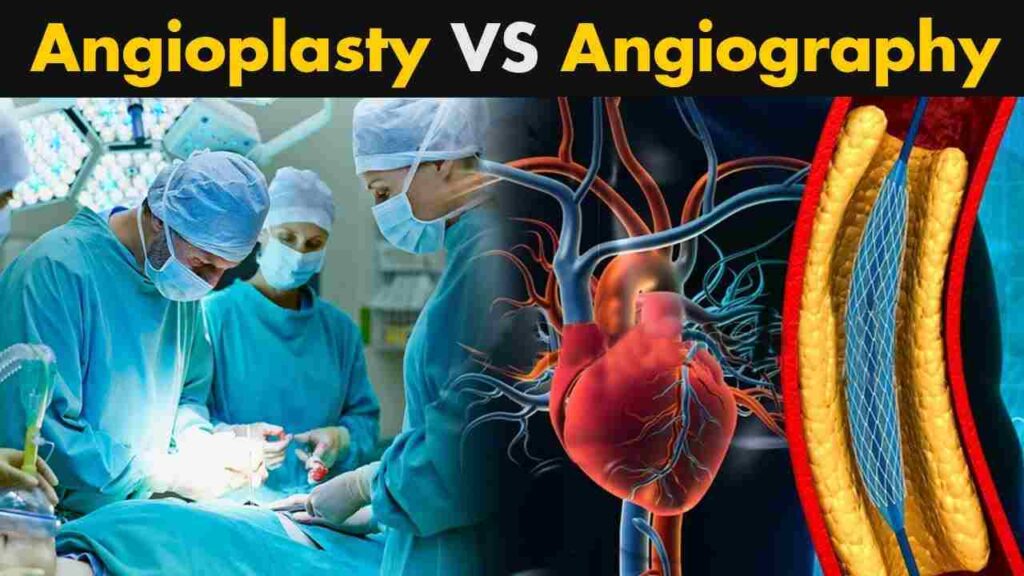
Explore 15 Key Difference between Angiography and Angioplasty
Angiography and angioplasty are two distinct medical procedures used in the diagnosis and treatment of cardiovascular conditions. While they are related and often performed in conjunction, it is important to understand the differences between them. Here, we will explore 15 key difference between angiography and angioplasty, shedding light on their unique characteristics.
15 Difference between angiography and angioplasty
Purpose: Angiography is primarily used as a diagnostic tool, enabling medical professionals to see inside blood vessels and spot obstructions or abnormalities. On the other hand, angioplasty is an interventional procedure used to treat obstructed or narrowed arteries.
Procedure: During an angiography, a contrast dye is injected into the blood vessels, and then the arteries are imaged in great detail using X-ray technology. A catheter containing a deflated balloon is inserted into the affected artery during an angioplasty procedure, and the balloon is then inflated to widen the vessel and restore blood flow.
Treatment focus: Angiograms are used to diagnose arterial blockages, giving precise information on their location and severity. However, angioplasty focuses on intervention, specifically the mechanical widening of artery that are narrowed.
Medical expertise: An interventional cardiologist or radiologist is required for both angiography and angioplasty due to their specialised training. These health care providers have received specialised training in carrying out and interpreting the procedures.
Anesthesia: Angiography is typically carried out while the patient is conscious but sedated or under local anaesthesia. In contrast, stronger anaesthesia is frequently administered during angioplasty in order to ensure the patient’s comfort throughout the invasive procedure.
Invasiveness: In order to perform an angiography, a catheter must be inserted into a blood vessel, typically through the wrist or groyne. In contrast, angioplasty necessitates the insertion of additional tools, like balloons and stents, in order to open the blocked artery, making it a more invasive procedure.
Recovery time: Angioplasty typically requires a longer recovery time than angiography. Patients can generally return to their regular routines soon after an angiography. On the other hand, because of how invasive angioplasty is, a longer recovery period might be necessary.
Risks: While there are some risks associated with both procedures, angioplasty has a slightly higher risk profile because of how invasive it is. Bleeding, infection, allergic reactions to contrast dye, and arterial damage are among the risks of angioplasty.
Success rate: Angiography is a diagnostic tool, so it has no direct effect on how well a treatment works. The success rate of angioplasty, in contrast, varies depending on the location and severity of the blockage and aims to increase blood flow by widening the narrowed artery.
Long-term outcomes: Since angiography is only used for diagnosis, it has no lasting effects. However, by restoring blood flow, easing symptoms, and averting complications linked to blocked arteries, angioplasty can significantly improve long-term outcomes.
Combination: Prior to angioplasty, an angiography is frequently performed to serve as a guide for the interventional radiologist or cardiologist performing the procedure. The angiography images assist in the decision-making process during angioplasty by identifying the exact location and degree of the blockage.
Alternatives: Angioplasty may not always be advised in place of other options, such as medication or bypass surgery. Based on the patient’s condition, angiograms assist in selecting the best treatment option.
Time requirement: Angiography typically takes less time to complete than angioplasty, in general. On the other hand, angioplasty can take longer, especially if there are several blockages present or if additional procedures, like the implantation of a stent, are necessary.
Follow-up: Patients may need additional diagnostic exams or consultations after an angiography to go over the findings and choose the best course of action. Following angioplasty, it is crucial to schedule routine follow-up appointments to assess the procedure’s effectiveness and the patient’s general cardiovascular health.
Cost: Because the interventional procedure necessitates more supplies and equipment, angiography is typically less expensive than angioplasty. However, the overall cost may change based on the medical facility, the location, and the insurance coverage.
Understanding the difference between angiography and angioplasty is crucial for patients and their families, as it provides clarity on the diagnostic and interventional aspects of cardiovascular care. Both procedures play vital roles in managing and treating cardiovascular conditions, with the ultimate aim of improving patients’ quality of life and reducing the risks associated with arterial blockages.
Also Read: Understand the Time difference between India and China